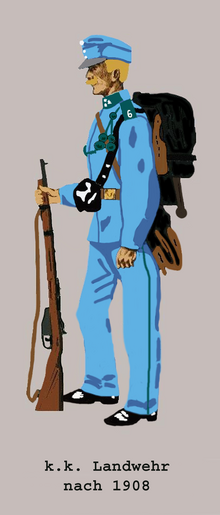
Back الجيش النمساوي المجري Arabic Сухапутныя сілы Аўстра-Венгрыі Byelorussian Exèrcit austrohongarès Catalan Rakousko-uherská armáda Czech Østrig-ungarske hær Danish Landstreitkräfte Österreich-Ungarns 1867–1914 German Αυστροουγγρικός Στρατός Ξηράς Greek Aŭstria-hungara armeo Esperanto Ejército austrohúngaro Spanish Armée de terre austro-hongroise French
This article needs additional citations for verification. (April 2022) |
| Army of Austria-Hungary | |
|---|---|
| Landstreitkräfte Österreich-Ungarns (German), literally "Land Forces of Austria-Hungary" Császári és Királyi Hadsereg (Hungarian), literally "Imperial and Royal Army" | |
 | |
| Active | 1867–1918 |
| Country | |
| Allegiance | |
| Branch |
|
| Type | Army |
| Size | 7,800,000 c. 1917 |
| Part of | Austro-Hungarian Armed Forces |
| Engagements | |
| Commanders | |
| Commander-in-chief | Emperor of Austria |

The Austro-Hungarian Army, also known as the Imperial and Royal Army,[A. 1] was the principal ground force of Austria-Hungary from 1867 to 1918. It consisted of three organisations: the Common Army (German: Gemeinsame Armee, recruited from all parts of Austria-Hungary), the Imperial-Royal Landwehr (recruited from Cisleithania) and the Royal Hungarian Honvéd (recruited from Transleithania).
In the wake of fighting between the Austrian Empire and the Kingdom of Hungary and the subsequent two decades of uneasy co-existence, Hungarian troops served either in ethnically mixed units or were stationed away from Hungarian regions. With the Austro-Hungarian Compromise of 1867, the Austro-Hungarian Army was brought into being. It existed until the disestablishment of Austria-Hungary in 1918 following the end of World War I. Common Army units were generally poorly trained and had very limited access to new equipment, because the governments of the Austrian and Hungarian parts of the empire often preferred to generously fund their own units instead of outfitting all three army branches equally. All Landwehr and Honvéd regiments were composed of three battalions, while Common Army regiments had four.
The long-standing white infantry uniforms were replaced in the later half of the 19th century with dark blue tunics,[1] which in turn were replaced by cadet grey uniforms during the initial stages of World War I. In September 1915, field gray was adopted as the new official uniform colour.[2] As the Common Army was plagued with supply shortages, when field gray uniforms were first introduced, remaining stocks of the preexisting cadet grey uniforms remained in use alongside the newer colour. The last known surviving member of the Austro-Hungarian Army was Franz Künstler, who died in Bad Mergentheim in May 2008 at the age of 107.
Cite error: There are <ref group=A.> tags on this page, but the references will not show without a {{reflist|group=A.}} template (see the help page).
- ^ Rothenberg, G. (1976). The Army of Francis Joseph. West Lafayette, IN: Purdue University Press. p. 83. ISBN 0911198415.
- ^ Rothenberg 1976, p. 193.